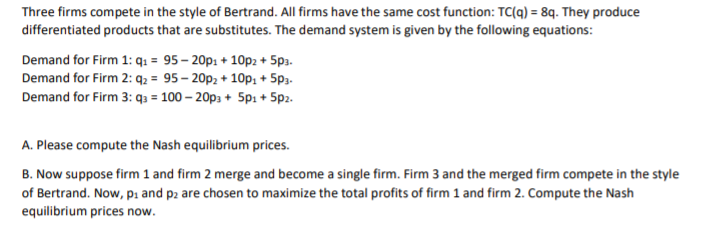Three firms compete in the style of Bertrand. All firms have the same cost function: TC(q) = 8q. They produ differentiated products that are substitutes. The demand system is given by the following equations: Demand for Firm 1: q: = 95– 20p: + 10p2 + 5p3. Demand for Firm 2: q2 = 95 – 20p2 + 10p; + 5p,- Demand for Firm 3: q3 = 100 – 20p3 + 5p: + 5p2. A. Please compute the Nash equilibrium prices. B. Now suppose firm 1 and firm 2 merge and become a single firm. Firm 3 and the merged firm compete in of Bertrand. Now, pi and p2 are chosen to maximize the total profits of firm 1 and firm 2. Compute the Nas equilibrium prices now.
Three firms compete in the style of Bertrand. All firms have the same cost function: TC(q) = 8q. They produ differentiated products that are substitutes. The demand system is given by the following equations: Demand for Firm 1: q: = 95– 20p: + 10p2 + 5p3. Demand for Firm 2: q2 = 95 – 20p2 + 10p; + 5p,- Demand for Firm 3: q3 = 100 – 20p3 + 5p: + 5p2. A. Please compute the Nash equilibrium prices. B. Now suppose firm 1 and firm 2 merge and become a single firm. Firm 3 and the merged firm compete in of Bertrand. Now, pi and p2 are chosen to maximize the total profits of firm 1 and firm 2. Compute the Nas equilibrium prices now.
Practical Management Science
6th Edition
ISBN:9781337406659
Author:WINSTON, Wayne L.
Publisher:WINSTON, Wayne L.
Chapter2: Introduction To Spreadsheet Modeling
Section: Chapter Questions
Problem 35P
Related questions
Question
A4

Transcribed Image Text:Three firms compete in the style of Bertrand. All firms have the same cost function: TC(q) = 8q. They produce
differentiated products that are substitutes. The demand system is given by the following equations:
Demand for Firm 1: q: = 95– 20p: + 10p2 + 5p3.
Demand for Firm 2: q2 = 95 – 20p2 + 10p: + 5p3.
Demand for Firm 3: q3 = 100 – 20p3 + 5pi + 5p2.
A. Please compute the Nash equilibrium prices.
B. Now suppose firm 1 and firm 2 merge and become a single firm. Firm 3 and the merged firm compete in the style
of Bertrand. Now, pi and p2 are chosen to maximize the total profits of firm 1 and firm 2. Compute the Nash
equilibrium prices now.
Expert Solution
This question has been solved!
Explore an expertly crafted, step-by-step solution for a thorough understanding of key concepts.
Step by step
Solved in 4 steps with 1 images

Recommended textbooks for you

Practical Management Science
Operations Management
ISBN:
9781337406659
Author:
WINSTON, Wayne L.
Publisher:
Cengage,

Practical Management Science
Operations Management
ISBN:
9781337406659
Author:
WINSTON, Wayne L.
Publisher:
Cengage,